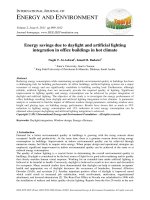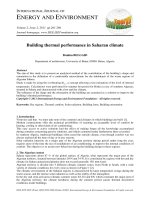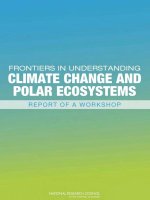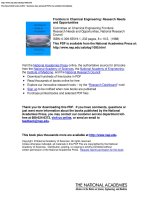frontiers in decandal climate variability
Bạn đang xem bản rút gọn của tài liệu. Xem và tải ngay bản đầy đủ của tài liệu tại đây (10.29 MB, 92 trang )
Free ebooks ==> www.Ebook777.com
www.Ebook777.com
Frontiers in Decadal Climate Variability: Proceedings of a Workshop
Free ebooks ==> www.Ebook777.com
FR
RONT
TIERSS IN DECA
D ADALL
C
CLIM
MATE VARIIABILLITY
Proceedings of a Worrkshop
Ama
anda Purce
ell and Na
ancy Hudd
dleston, R
Rapporteurs
Boarrd on Atmosph
heric Science s and Climatee
Ocean
n Studies Boa rd
Division on Earth and Lifee Studies
www.Ebook777.com
Copyright © National Academy of Sciences. All rights reserved.
Frontiers in Decadal Climate Variability: Proceedings of a Workshop
THE NATIONAL ACADEMIES PRESS 500 Fifth Street, NW Washington, DC 20001
This project was supported by the US Department of Energy under contract number DESC0014286, the National Aeronautics and Space Administration under contract number
NNX08AB07G, the National Oceanic and Atmospheric Administration under contract number
NA14OAR4310301, and the National Science Foundation under award number AGS1507493. Any opinions, findings, conclusions, or recommendations expressed in this
publication do not necessarily reflect the views of any organization or agency that provided
support for the project.
International Standard Book Number-13: 978-0-309-44461-3
International Standard Book Number-10: 0-309-44461-6
Digital Object Identifier: 10.17226/23552
Additional copies of this report are available for sale from the National Academies Press, 500
Fifth Street, NW, Keck 360, Washington, DC 20001; (800) 624-6242 or (202) 334-3313;
.
Copyright 2016 by the National Academy of Sciences. All rights reserved.
Printed in the United States of America.
Suggested citation: National Academies of Sciences, Engineering, and Medicine. 2016.
Frontiers in Decadal Climate Variability: Proceedings of a Workshop. Washington, DC:
National Academies Press. DOI: 10.17226/23552.
Cover: A regression map of Pacific sea surface temperature variability. Figure modified after
Di Lorenzo et al. (2015).
Copyright © National Academy of Sciences. All rights reserved.
Frontiers in Decadal Climate Variability: Proceedings of a Workshop
The Na
ational Academ
my of Science
es was establisshed in 1863 b
by an Act of C
Congress, signe
ed by Presiden
nt
Lincoln, as a private, nongovernme
ental institutio
on to advise tthe nation on issues related to science an
nd
technollogy. Memberss are elected by their peerrs for outstan ding contributtions to resea
arch. Dr. Marccia
McNutt is president.
The National Academ
my of Engineerring was estab
blished in 1964 under the chaarter of the Na
ational Academ
my
of Scien
nces to bring the practices off engineering to
t advising the
e nation. Memb
bers are electe
ed by their pee
ers
for extrraordinary contributions to engineering.
e
Drr. C. D. Mote, JJr., is presiden
nt.
The National Academ
my of Medicine
e (formerly the
e Institute of M
Medicine) was established in 1970 under th
he
charterr of the Nation
nal Academy of Sciences to advise
a
the nattion on medicaal and health iissues. Membe
ers
are ele
ected by their peers for disttinguished con
ntributions to medicine and health. Dr. V
Victor J. Dzau is
preside
ent.
The thrree Academiess work togethe
er as the Natio
onal Academiess of Sciences, Engineering, a
and Medicine tto
provide
e independent, objective an
nalysis and advvice to the naation and cond
duct other acttivities to solvve
comple
ex problems and
a
inform pu
ublic policy de
ecisions. The Academies allso encourage education an
nd
researc
ch, recognize outstanding
o
contributions to knowledge, an
nd increase pu
ublic understan
nding in matte
ers
of scien
nce, engineerin
ng, and mediciine.
Learn more
m
about th
he National Academies of Sciences,
S
Engi neering, and Medicine at w
www. nationa
alacadem
mies. org.
Copyright © National Academy of Sciences. All rights reserved.
Frontiers in Decadal Climate Variability: Proceedings of a Workshop
Free ebooks ==> www.Ebook777.com
Reporrts document the evidence-ba
ased consensuss of an authoriing committee of experts. Re
eports typicallyy
include findings, con
nclusions, and recommendatiions based on iinformation gaathered by the committee an
nd
wed and are a pproved by the
e National Aca
ademies of
committee deliberattions. Reports are peer review
ces, Engineerin
ng, and Medicin
ne.
Scienc
cle the presenttations and disc
cussions at a w
workshop, symp
posium, or other convening
Proceedings chronic
event.. The statemen
nts and opinion
ns contained in
n proceedings aare those of th
he participants and are not
necesssarily endorsed
d by other partticipants, the planning
p
comm
mittee, or the N
National Acade
emies of
Scienc
ces, Engineerin
ng, and Medicin
ne.
ut other products and activitties of the Acad
demies, please
e visit
For infformation abou
nation
nalacademies.o
org/whatwedo..
www.Ebook777.com
Copyright © National Academy of Sciences. All rights reserved.
Frontiers in Decadal Climate Variability: Proceedings of a Workshop
COMMITTEE ON FRONTIERS IN DECADAL CLIMATE VARIABILITY: A WORKSHOP
GERALD A. (JERRY) MEEHL (Chair), National Center for Atmospheric Research, Boulder, Colorado
KEVIN ARRIGO, Stanford University, California
SHUYI S. CHEN, University of Miami, Florida
LISA GODDARD, Columbia University, Palisades, New York
ROBERT HALLBERG, Princeton University and National Oceanic and Atmospheric Administration,
Princeton, New Jersey
DAVID HALPERN, National Aeronautics and Space Administration, Pasadena, California
National Academies of Sciences, Engineering, and Medicine Staff
AMANDA PURCELL, Associate Program Officer, Board on Atmospheric Sciences and Climate
(BASC)
NANCY HUDDLESTON, Communications Officer, Division on Earth and Life Sciences (DELS)
DEBORAH GLICKSON, Senior Program Officer, Ocean Studies Board (OSB) (through August 2015)
RITA GASKINS, Administrative Coordinator, BASC
v
Copyright © National Academy of Sciences. All rights reserved.
Frontiers in Decadal Climate Variability: Proceedings of a Workshop
BOARD ON ATMOSPHERIC SCIENCES AND CLIMATE
A.R. RAVISHANKARA (Chair), Colorado State University, Fort Collins
GERALD A. MEEHL (Vice Chair), National Center for Atmospheric Research, Boulder, Colorado
LANCE F. BOSART, State University of New York, Albany
MARK A. CANE, Columbia University, Palisades, New York
SHUYI S. CHEN, University of Miami, Florida
HEIDI CULLEN, Climate Central, Princeton, New Jersey
PAMELA EMCH, Northrop Grumman Aerospace Systems, Redondo Beach, California
ARLENE FIORE, Columbia University, Palisades, New York
WILLIAM B. GAIL, Global Weather Corporation, Boulder, Colorado
LISA GODDARD, Columbia University, Palisades, New York
MAURA HAGAN, Utah State University, Logan
TERRI S. HOGUE, Colorado School of Mines, Golden
ANTHONY JANETOS, Boston University, Massachusetts
EVERETTE JOSEPH, SUNY University at Albany, New York
RONALD “NICK” KEENER, JR., Duke Energy Corporation, Charlotte, North Carolina
JOHN R. NORDGREN, The Climate Resilience Fund, Bainbridge Island, Washington
JONATHAN OVERPECK, University of Arizona, Tucson
ARISTIDES A.N. PATRINOS, New York University, Brooklyn
S.T. RAO, North Carolina State University, Raleigh
DAVID A. ROBINSON, Rutgers, The State University of New Jersey, Piscataway
CLAUDIA TEBALDI, National Center for Atmospheric Research, Climate Central, Boulder, Colorado
Ocean Studies Board Liaison
DAVID HALPERN, Jet Propulsion Laboratory, Pasadena, California
Polar Research Board Liaison
JENNIFER FRANCIS, Rutgers, The State University of New Jersey, Marion, Massachusetts
National Academies of Sciences, Engineering, and Medicine Staff
AMANDA STAUDT, Director
EDWARD DUNLEA, Senior Program Officer
LAURIE GELLER, Program Director
KATHERINE THOMAS, Senior Program Officer
LAUREN EVERETT, Program Officer
ALISON MACALADY, Program Officer
AMANDA PURCELL, Associate Program Officer
RITA GASKINS, Administrative Coordinator
ROB GREENWAY, Program Associate
SHELLY FREELAND, Financial Associate
MICHAEL HUDSON, Senior Program Assistant
ERIN MARKOVICH, Program Assistant
vi
Copyright © National Academy of Sciences. All rights reserved.
Frontiers in Decadal Climate Variability: Proceedings of a Workshop
OCEAN STUDIES BOARD
LARRY A. MAYER (Chair), University of New Hampshire, Durham
E. VIRGINIA ARMBRUST, University of Washington, Seattle
KEVIN R. ARRIGO, Stanford University, California
CLAUDIA BENITEZ-NELSON, University of South Carolina, Columbia
RITA R. COLWELL, University of Maryland, College Park
SARAH W. COOKSEY, State of Delaware, Dover
CORTIS K. COOPER, Chevron Corporation, San Ramon, California
JAMES A. ESTES, University of California, Santa Cruz
DAVID HALPERN, Jet Propulsion Laboratory, Pasadena, California
PATRICK HEIMBACH, University of Texas, Austin
SUSAN E. HUMPHRIS, Woods Hole Oceanographic Institution, Woods Hole, Massachusetts
BONNIE J. MCCAY, Rutgers University, New Brunswick, New Jersey
S. BRADLEY MORAN, University of Alaska, Fairbanks
STEVEN A. MURAWSKI, University of South Florida, St. Petersburg
JOHN A. ORCUTT, Scripps Institution of Oceanography, La Jolla, California
H. TUBA ÖZKAN-HALLER, Oregon State University, Corvallis
MARTIN D. SMITH, Duke University, Durham, North Carolina
MARGARET SPRING, Monterey Bay Aquarium, Monterey, California
DON WALSH, International Maritime Incorporated, Myrtle Point, Oregon
DOUGLAS WARTZOK, Florida International University, Miami
LISA D. WHITE, University of California, Berkeley and San Francisco State University
ROBERT S. WINOKUR, Michigan Tech Research Institute, Maryland
National Academies of Sciences, Engineering, and Medicine Staff
SUSAN ROBERTS, Director
CLAUDIA MENGELT, Senior Program Officer
STACEE KARRAS, Associate Program Officer
PAMELA LEWIS, Administrative Coordinator
PAYTON KULINA, Senior Program Assistant
SHUBHA BANSKOTA, Financial Associate
HEATHER COLEMAN, Postdoctoral Fellow
vii
Copyright © National Academy of Sciences. All rights reserved.
Frontiers in Decadal Climate Variability: Proceedings of a Workshop
Copyright © National Academy of Sciences. All rights reserved.
Frontiers in Decadal Climate Variability: Proceedings of a Workshop
Free ebooks ==> www.Ebook777.com
Acknowledgments
T
his Proceedings of a Workshop has been reviewed in draft form by individuals
chosen for their diverse perspectives and technical expertise. The purpose of this
independent review is to provide candid and critical comments that will assist the
institution in making its published proceedings as sound as possible and to ensure that the
proceedings meets institutional standards for objectivity, evidence, and responsiveness to
the study charge. The review comments and draft manuscript remain confidential to protect
the integrity of the process. We wish to thank the following individuals for their review of
this proceedings:
Lisa Goddard, Columbia University
Philip Jones, University of East Anglia
Veronica Nieves, NASA Jet Propulsion Laboratory
Gavin Schmidt, NASA Goddard Institute for Space Studies
Although the reviewers listed above have provided many constructive comments and
suggestions, they did not see the final draft of the Proceedings of a Workshop before public
release. The review of this proceedings was overseen by Xubin Zeng, University of Arizona;
he was responsible for making certain that an independent examination of this proceedings
was carried out in accordance with institutional procedures and that all review comments
were carefully considered. Responsibility for the final content of this proceedings rests
entirely with the authors and the institution.
ix
www.Ebook777.com
Copyright © National Academy of Sciences. All rights reserved.
Frontiers in Decadal Climate Variability: Proceedings of a Workshop
Copyright © National Academy of Sciences. All rights reserved.
Frontiers in Decadal Climate Variability: Proceedings of a Workshop
Contents
Overview
1
Introduction
5
Challenges in Examining Climate Trends
9
Modes and Mechanisms of Internal Variability
13
The Role of External Forcing
31
Overcoming Data Limitations
35
Toward Predictability
43
Frontiers and Research Opportunities
47
References
51
Appendix A—Statement of Task
59
Appendix B—Planning Committee Biographical Sketches
61
Appendix C—Workshop Agenda
65
Appendix D—Workshop Participants
69
Appendix E—Panel Presentation Abstracts
71
Appendix F—Song Lyrics
79
xi
Copyright © National Academy of Sciences. All rights reserved.
Frontiers in Decadal Climate Variability: Proceedings of a Workshop
Copyright © National Academy of Sciences. All rights reserved.
Frontiers in Decadal Climate Variability: Proceedings of a Workshop
Overview
M
any factors contribute to variability in Earth’s climate on a range of timescales,
from seasons to decades. Natural climate variability arises from two different
sources: (1) internal variability from interactions among components of the
climate system, for example, between the ocean and the atmosphere, and (2) natural
external forcings, such as variations in the amount of radiation from the Sun. External
forcings on the climate system also arise from some human activities, such as the emission
of greenhouse gases (GHGs) and aerosols. The climate that we experience is a combination
of all of these factors.
Understanding climate variability on the decadal timescale is important to decision-making.
Planners and policy makers want information about decadal variability in order to make
decisions in a range of sectors, including for infrastructure, water resources, agriculture, and
energy.
In September 2015, the Board on Atmospheric Sciences and Climate and the Ocean
Studies Board of the National Academies of Sciences, Engineering, and Medicine convened
a workshop1 (Statement of Task in Appendix A) to examine variability in Earth’s climate on
decadal timescales, defined as 10 to 30 years. During the workshop, ocean and climate
scientists reviewed the state of the science of decadal climate variability and its relationship
to rates of human-caused global warming, and they explored opportunities for
improvement in modeling and observations and assessing knowledge gaps. This report
summarizes the workshop presentations and discussions. As such, it is a snapshot of how
leading U. S. scientists were approaching the topic at the time. This report does not attempt
to provide a complete overview of this rapidly advancing field or present any work not
discussed at the workshop or any new work published since the workshop.
The scientific community broadly agrees that the planet as a whole is warming steadily
through time (IPCC, 2014). Many workshop participants acknowledged that climate
variability can cause the rate of warming to shift over periods lasting from years to a few
decades. Internal climate variability can result from shifts in the absorption and transport of
heat into the ocean, leading to periods when Earth’s surface warms more slowly or more
rapidly. Key points from workshop participants for framing the discussions ahead are
highlighted in Box 1.
Since 1880, the average temperature at Earth’s surface has increased by about 0.85°C. Most
of this increase (about 0.72°C) has occurred since 1951 (Hartmann et al., 2013). A number
of recent studies indicate that the global mean surface warming trend slowed to near zero
(0.07±0.08°C per decade) in the first to second decades of the 21st century (Easterling and
Wehner, 2009; Hartmann et al., 2013; Kosaka and Xie, 2013) in relation to the trend during
the latter half of the 20th century (i. e., 1950-2012). This slowdown in GMST rise has
spurred much research aimed at examining recent and past climate variability in order to
understand and better predict decadal climate trends. This period, typically defined as a
range between 1998 to 2014, is referred to throughout this report as the “slowdown.” The
scientific community, the media, and some workshop participants have also broadly used
1
This report has been prepared by the workshop rapporteur as a factual summary of what occurred at
the workshop. The planning committee’s role was limited to planning and convening the workshop.
The views contained in the report are those of individual workshop participants and do not
necessarily represent the views of all workshop participants, the planning committee, or the National
Academies of Sciences, Engineering, and Medicine.
1
Copyright © National Academy of Sciences. All rights reserved.
Frontiers in Decadal Climate Variability: Proceedings of a Workshop
2
Frontiers in Decadal Climate Variability: Proceedings of a Workshop
BOX 1
Key Points
During the workshop, participants identified the following points as a foundation for discussions of decadal climate
variability:
The Earth system (land, atmosphere, and ocean) continues to steadily warm through time in response to
increasing greenhouse gases (GHGs) in the atmosphere from human activities.
Global mean surface temperature (GMST) is increasing as the Earth warms, but the rate of surface warming
fluctuates because of variability in the internal dynamics of the climate system and in contributions of external
forcings.
Internal climate variability arises from changes in the transport of heat in the climate system (e. g., in the
ocean, or from the atmosphere into the ocean), leading to periods when the surface warms more slowly or
more rapidly.
A slowdown in the rise of GMST is not equivalent to a slowdown in global warming. Viewed over long time
periods (50+ years), there is a persistent increase in GMST. However, it remains important to understand the
decadal variability in GMST that is observed over shorter time periods.
the terms “hiatus” and “warming pause,” but through the discussions, many participants
agreed that “slowdown” is a more accurate term because it does not suggest that
something, specifically human-caused climate change, halted during this period (see Box 1,
bullet 4).
A major line of inquiry discussed at the workshop is the degree to which natural variability
modulated human-caused climate change during the recent warming slowdown, as well as
during past periods of increased or accelerated warming, such as from 1970 to 1998. Also
discussed was the extent to which previous results are a function of data coverage or
remaining biases in sea surface temperature (SST) reconstructions. Some research has
indicated that the early-2000s warming slowdown does not appear to be as pronounced if
incomplete observed data coverage over the Arctic or errors in calibration of SST
observations are taken into account (e. g., Cowtan and Way, 2014; Karl et al., 2015).
Much of the workshop discussion focused on the mechanisms governing decadal
variability. Several participants presented evidence that the recent slowdown is driven in
large part by well-documented swings in Pacific SSTs and sea level pressure known as the
Interdecadal Pacific Oscillation (IPO). Other research has made the case that external
forcing also played a role; for example, multiple small- to moderate- sized volcanoes have
produced an accumulation of aerosols in the stratosphere that contribute to cooling (e. g.,
Ridley et al., 2014; Santer et al., 2014).
The specific mechanisms driving decadal variability, not only in the Pacific but also in all of
the ocean basins, are subjects of intense scientific inquiry. Workshop participants shared
research into potential mechanisms driving Pacific temperature swings, including storage of
excess heat in the deeper ocean, movement of heat to the Indian Ocean, wind-driven
changes, and teleconnections with the Atlantic Ocean. Proposed mechanisms of Atlantic
variability include changes induced by the ocean’s major current (the Atlantic Meridional
Overturning Circulation, or AMOC) and its relationship to the North Atlantic Oscillation
(NAO). Also discussed was variability in the Indian Ocean and polar regions.
Because the storage of heat in the ocean has been implicated in the recent warming
slowdown as measured by GMST, participants discussed the limitations of using GMST as
the primary metric of global climate change. Many participants supported the notion that,
because 93 percent of the excess heat from GHGs is stored in the ocean, sea-level rise, or
sea-level rise together with GMST, may be a more appropriate metric of global climate
change.
Copyright © National Academy of Sciences. All rights reserved.
Frontiers in Decadal Climate Variability: Proceedings of a Workshop
Overview
3
Variability at decadal timescales is a well-known feature of the climate system. Climate
models produce periods of slower and more accelerated warming, although a specific
slowdown in the GMST warming trend in the early 2000s was not directly projected by
climate models (the warming trend during this period was near the lower edge of the 5-95
percent range of projections from the Coupled Model Intercomparison Project Phase 5;
Schmidt et al., 2014). Many participants agreed that being able to predict decadal
variability would be important given its implications, for example, its link to important
regional phenomenon such as drought. Much remains to be learned before scientists will
be able to make skillful predictions of variability on these timescales, however.
Workshop participants discussed the importance of advancing understanding of how all of
the physical mechanisms in the ocean and atmosphere work in concert to produce decadal
variability in the GMST and of improving observations and modeling capabilities in order to
make predictions. Participants identified the continuation and improvement of ocean and
atmospheric monitoring as well as more creative ways to use existing data, including
paleoclimate data and synthesis products from models, as possible opportunities to improve
predictions.
The study of Earth’s climate system involves a large and diverse group of experts.
Participants commented on the great value provided by bringing together a diversity of
researchers to discuss key challenges and opportunities in the field of decadal climate
variability.
Copyright © National Academy of Sciences. All rights reserved.
Frontiers in Decadal Climate Variability: Proceedings of a Workshop
Copyright © National Academy of Sciences. All rights reserved.
Frontiers in Decadal Climate Variability: Proceedings of a Workshop
Introduction
S
tudies of historic and paleoclimate data (e. g., NRC, 1998), as well as climate model
simulations (e. g., Easterling and Wehner, 2009), demonstrate that Earth’s climate
system exhibits natural variability at a wide range of timescales because of both
internal and external factors (see Box 2). Decadal climate variability refers to variability of
regional and global climate on timescales of 10 to 30 years. 1 Longer trends (50 years or
more) in observed global mean surface temperature (GMST) in the recent century largely
reflect increases in anthropogenic greenhouse gases (GHGs; e. g., Bindoff et al., 2013).
Decadal variability can be described as the ups and downs of the climate, which are
superimposed on that trend (see Figure 1). In this way, decadal variability can accelerate or
decelerate the rate of warming on shorter timescales, whereas climate change is dominated
by the steady warming from increasing GHGs over the long term.
The slowdown in the GMST warming trend during the early 2000s spurred a lot of research
aimed at identifying variability in observations and models, as well as attributing its
mechanisms. What physical mechanisms can explain recent as well as past decadal
variability? How much of the variability in recent trends in surface warming is due to
internal, natural variability versus external forcing, and how does this attribution vary as a
function of timescale? Given what is known today about the controls on decadal variability,
what can be said about the future? Are such accelerations and slowdowns predictable?
What observations, data synthesis, and improvements in climate models might be needed
to provide comprehensive answers to such questions? Finally, what is the best way to
measure the influence of human-emitted GHGs on the global climate? Is GMST the best
BOX 2
Definitions of Climate Variability and Climate Change
The following definitions are taken from the Intergovernmental Panel on Climate Change 5th Assessment Report (IPCC,
2014) and are provided as background to the discussions summarized below.
Climate change refers to a change in the state of the climate that can be identified (e. g., by using statistical tests) by
changes in the mean and/or the variability of its properties and that persists for an extended period, typically decades or
longer. Climate change may be due to natural internal processes or external forcings such as modulations of the solar
cycles, volcanic eruptions, and persistent anthropogenic changes in the atmosphere’s composition or land use.
The climate system is the highly complex system consisting of five major components: atmosphere, hydrosphere,
cryosphere, lithosphere, and biosphere and the interactions among them. The climate system evolves in time in
response to internal dynamics and external forcings such as volcanic eruptions, solar variations, and anthropogenic
changes in the atmosphere’s composition or land use.
External forcing refers to an external agent that causes a change in the climate system. Volcanic eruptions, solar
variations, and anthropogenic changes in the atmosphere’s composition and land use are external forcings. Orbital
forcing is also an external forcing because the insolation changes with orbital parameters such as eccentricity, tilt, and
precession of the equinox.
Climate variability refers to variations in the mean state and other statistics (e. g., standard deviations, occurrence of
extremes) of the climate on all spatial and temporal scales beyond that of individual weather events. Variability may be
due to natural processes internal to the climate system or to natural or anthropogenic external forcing. Variability of the
climate occurs on a variety of timescales—from seasons to decades to millennia.
1
Participants noted that while the timescale of decadal climate variability is approximately 10-30
years, the mechanisms and drivers of this variability occur at a variety of timescales, for example,
ENSO (see Box 3).
5
Copyright © National Academy of Sciences. All rights reserved.
Frontiers in Decadal Climate Variability: Proceedings of a Workshop
6
Fro
ontiers in Decaddal Climate Var
ariability: Proceeedings of a Wo
orkshop
FIGURE 1 This
T schematic illustrates natural decadal clim
mate variabilityy in GMST (bluee), which is sup
perimposed on the
long-term forcing
f
from GH
HGs (change in
n dotted baselin
ne indicated witth red arrows). NOTE: The normal ups and d
downs
of natural variability
v
are th
hen accelerated
d or decelerated
d by the long-teerm warming, p
producing a new
w curve that
represents the
t combinatio
on of natural variability and hu
uman-caused w
warming (maroo
on). SOURCE: A
Adapted from G
Gerald
Meehl pressentation, Septe
ember 3, 2015.
metric? Regardless of
o the measure
e, what metho
ods can best eevaluate inflecctions in the rate of
e change?
climate
The im
mportance of answering
a
these and related
d questions exxtends beyond
d explaining the
recent slowdown in surface warm
ming: The abillity to anticipaate, and eventtually predict,, such
es is importan
nt to decision-making. Plan ners and policcy makers waant information
change
about decadal varia
ability to make
e decisions in a range of secctors, includin
ng for
griculture, and
d energy. Furtthermore, likee the well-stud
died
infrastrructure, waterr resources, ag
El Niño
o and La Niña
a interannual variations, deecadal climatee variability iss associated w
with
specific regional pattterns of temp
perature and p
precipitation, ssuch as heat w
waves, cold sp
pells,
xample, some
e of the same mechanisms rresponsible fo
or the recent
and drroughts. For ex
warming slowdown may have pla
ayed a role in
n the extended
d drought in th
he U. S. westeern
( g., Delworth et al., 2015
5). Clarifying tthe processes behind the reecent slowdow
wn in
states (e.
GMST rise can imprrove understanding and preediction of reggional climatee, which in turn
ns that affect our
o society (e. g., Murphy ett al., 2010).
can infform decision
In Septtember 2015, the Board on
n Atmosphericc Sciences and
d Climate and
d the Ocean
Studiess Board of the
e National Aca
ademies of Scciences, Engin
neering, and M
Medicine convvened
Copyright © National Academy of Sciences. All rights reserved.
Frontiers in Decadal Climate Variability: Proceedings of a Workshop
Introduction
Free ebooks ==> www.Ebook777.com
a workshop to examine these questions (see Statement of Task in Appendix A). The
workshop included a number of panels followed by open discussions, as well as breakout
groups focused on specific modeling and observational challenges, and concluded with
reflections on the workshop’s key messages and lessons on communicating these messages
(see workshop agenda in Appendix B).
www.Ebook777.com
Copyright © National Academy of Sciences. All rights reserved.
7
Frontiers in Decadal Climate Variability: Proceedings of a Workshop
Copyright © National Academy of Sciences. All rights reserved.
Frontiers in Decadal Climate Variability: Proceedings of a Workshop
Challenges in Examining Climate
Trends
M
any participants noted that conversations about climate trends should clearly
specify which time periods defined the trend, which period served as the baseline
for determining the trend, and how the trend was quantified. However, not every
workshop presented provided these specifications when discussing the slowdown. The
presentations spurred discussion about whether the global mean surface temperature
(GMST) warming trend did indeed slow down during the early 2000s—the answer to which
depended on the timescale chosen and the quantification method used.
The discussion about ways to frame climate trends was motivated in part by a paper
released by Karl et al. (2015) prior to the workshop, which suggested that the slowdown
during the early 2000s was an artifact of residual data biases in the calculation of GMST
from an early version of a global surface temperature dataset.1 Karl et al. based their paper
on recent updates to the National Oceanic and Atmospheric Administration (NOAA) GMST
dataset, which revealed that the surface ocean
has warmed nearly twice as fast in recent years
Explanation of NOAA’s Improved
as previously thought. When combined with
Operational Dataset
updated land surface temperature data, which
Karl et al. (2015) explains the changes to
show a slight increase in the rate of land
NOAA’s dataset:
surface warming, the GMST data show a small
The data used in our long-term global
but significant positive trend (at the 0.10 level)
temperature analysis primarily involve
in GMST from 1998 to 2012.
Huai-Min Zhang, a scientist from the NOAA
National Centers for Environmental Information
(NCEI), said that with these corrections the
trend for 1998-2012 is not statistically
significantly different from the estimates for the
trend for 1951-2012. Zhang suggested that the
years used in the Intergovernmental Panel on
Climate Change analysis of GMST (IPCC, 2014)
do not provide a very good picture of decadal
warming trends, because the analysis period is
short and started with 1998 (one of the warmest
years on record because of a large El Niño
event). With the updated dataset and an
extended analysis period (1998-2014 or 20002014), recent warming rates are even higher
and, for the latter period, comparable to
warming rates of the second half of the 20th
century.
Gerald Meehl, chair of the workshop
organizing committee and senior scientist at the
National Center for Atmospheric Research,
surface air temperature observations
taken at thousands of weather-observing
stations over land, and for coverage
across oceans, the data are sea surface
temperature (SST) observations taken
primarily by thousands of commercial
ships and drifting surface buoys. These
networks of observations are always
undergoing change. Changes of particular
importance include (i) an increasing
amount of ocean data from buoys, which
are slightly different than data from ships;
(ii) an increasing amount of ship data
from engine intake thermometers, which
are slightly different than data from
bucket seawater temperatures; and (iii) a
large increase in land-station data, which
enables better analysis of key regions that
may be warming faster or slower than the
global average. We address all three of
these, none of which were included in
our previous analysis used in the IPCC
report. (p.1470)
1
HadSST3 (the Met Office Hadley Centre gridded SST dataset) made the SST adjustments made by
Karl et al. (2015) several years earlier prior; see Kennedy et al. (2011).
9
Copyright © National Academy of Sciences. All rights reserved.
Frontiers in Decadal Climate Variability: Proceedings of a Workshop
10
Fro
ontiers in Decaddal Climate Var
ariability: Proceeedings of a Wo
orkshop
FIGURE 2 Time
T
series of annual
a
GMST anomalies
a
in Fa
ahrenheit (dots) based on data from Karl et al.. (2015). NOTEEs:
Black line is
i linear trend computed
c
from 1950 to 2014 showing long-tterm trend forceed mainly by in
ncreasing GHG
Gs. Red
and blue lines show that the linear trend is dependent on
o time period cchosen (in this case, positive aand negative ph
hases
c Oscillation (IP
PO), respectivelly). SOURCE: M
Meehl (2015).
of the Interdecadal Pacific
presen
nted a graph of the GMST riise since the laate 1800s (Figgure 2) to dem
monstrate that
warming rates are se
ensitive to the
e years chosen
n to fit a linear trend. For exxample, from
5, the period of
o low or negaative trends in GMST was p
pronounced (ssee
about 1945 to 1975
gure 2). Howe
ever, over the longer term, tthe general w
warming trend is
light blue line in Fig
unced and cle
early evident. He described
d the global w
warming trend as an uneven
n
pronou
staircase: there are steeper
s
and le
ess steep perio
ods, but the treend over longger timescales has
been increasing, consistent with human-caused
h
d global warm
ming, regardleess of whetherr
s
period
ds exhibit statistically signifiicant positive (or negative) trends.
some shorter
John Fy
yfe from the Canadian
C
Cen
ntre for Climatte Modelling aand Analysis ((CCCma) and his
colleag
gues disagree with the argu
ument by Karl et al. (2015) that the slowd
down during tthe
early 2000s
2
is not ap
pparent after correcting
c
obsservations of gglobal sea surrface temperature.
Fyfe po
ointed out tha
at the baseline
e period used by Karl et al. (2015) for comparison inclludes
the so--called “big hiatus” (a perio
od of near-zerro trend in thee mid-20th cen
ntury, shown in
Figure 3); therefore the
t trend com
mputed for thee baseline periiod is low and
d not dissimilaar
ecent trends.
from re
Fyfe su
uggested that the
t baseline period
p
should be physicallyy based to reflect natural
variability. Using a baseline
b
perio
od of 1972-20
001, which exxcludes the “b
big hiatus,” Fyyfe
uded that a wa
arming slowdo
own did indeeed occur, relaative to 1972--2001 (see Fyffe at
conclu
al., 2016).
Copyright © National Academy of Sciences. All rights reserved.
Frontiers in Decadal Climate Variability: Proceedings of a Workshop
Challengess in Examining Climate
C
Trendss
11
FIGURE 3 GMST
G
anomalies based on Ha
adCRUT4.32 da
ata (blue), Karl et al. (2015) up
pdated dataset ((red), and estim
mated
anthropoge
enic forcing (bla
ack, using RCP;; Meinshausen et al., 2011) fro
om 1950 to 20 14. NOTES: Kaarl et al. anomalies
are relative
e to 1971-2000 climatology, and HadCRUT4.3 anomalies a re relative to 19
961-1990 climaatology. The Kaarl et
al. baseline
e includes the “big
“
hiatus” (sha
aded gray), whe
ereas the Fyfe eet al. baseline d
does not. SOUR
RCE: John Fyfe
presentation, September 3,
3 2015. © Her Majesty the Qu
ueen in Right o f Canada, as reepresented by th
he Minister of
Environment, 2016.
Workshop
p participants highlighted th
he fact that GM
MST variation
ns are expecteed in the
globally in
ntegrated Earth system. Cha
allenges to quantifying exacct rates and id
dentifying the
multitude of processes related to the differing ratess largely resullt from gaps in
n observationss
bility to measu
ure global ene
ergy changes in componen ts of Earth’s climate system
m.
and the ab
Nonethele
ess, participan
nts agreed thatt human-caussed changes to
o Earth’s energgy balance
have not been
b
on “hiatu
us” and are ca
ausing the pla
anet to warm o
on average ovver longer
timescaless.
Many partticipants also agreed that, regardless of whether
w
a tem
mporary slowdown in GMST
T
rise occurred between 1998 and 201
14, natural variations are exxpected in thee long-term
ure record for periods on the
e decadal tim
mescale. Unde rstanding of th
temperatu
his climate
variability
y will in turn in
nform understtanding of the
e physical clim
mate system ass well as
advance prediction
p
and
d attribution capabilities. So
ome participaants noted thatt framing the
discussion
n around whetther or not the
ere was a rece
ent slowdown
n period obscu
ures the
importanc
ce of understanding decada
al variability and
a its many cclimate impaccts. Much of th
he
remainderr of the workshop discussio
ons delved into
o research to uncover the ccontributions by
various intternal mechan
nisms and extternal forcing,, how they intteract to produ
uce global and
regional decadal
d
climatte variability, and the poten
ntial for increaased knowled
dge to lead to
prediction
ns of transition
ns between pe
eriods of slowe
er and faster w
warming of G
GMST in
response to
t GHG forcin
ng.
2
HadCRUT
T4.3 is a gridde
ed dataset of glo
obal historical surface
s
temperaature anomaliees relative to a
1961-1990
0 reference period. Data are av
vailable for each month since January 1850, on a 5 degree
grid. The dataset is a colla
aborative produ
uct of the Met Office
O
Hadley C
Centre and the C
Climatic
Research Unit
U at the Univ
versity of East Anglia. At the tim
me of this writin
ng, HadCRUT4
4.3 had been
updated to version HadCR
RUT4.4. Available at http://ww
ww.metoffice.go
ov.uk/hadobs/h
hadcrut4/.
Copyright © National Academy of Sciences. All rights reserved.
Frontiers in Decadal Climate Variability: Proceedings of a Workshop
Copyright © National Academy of Sciences. All rights reserved.









